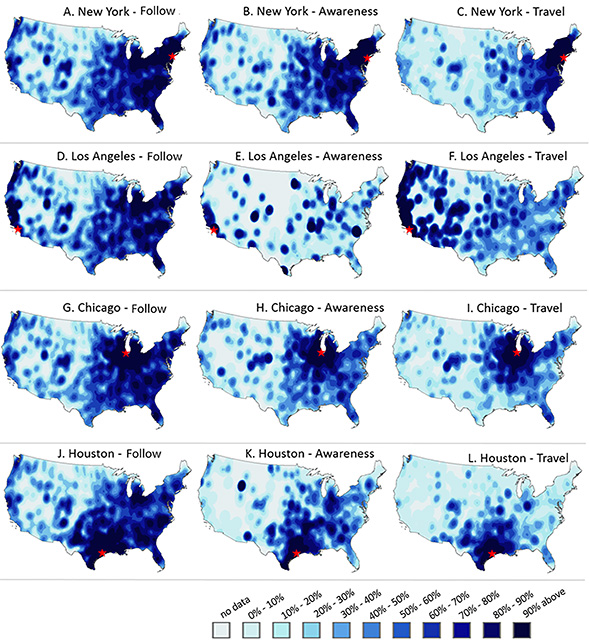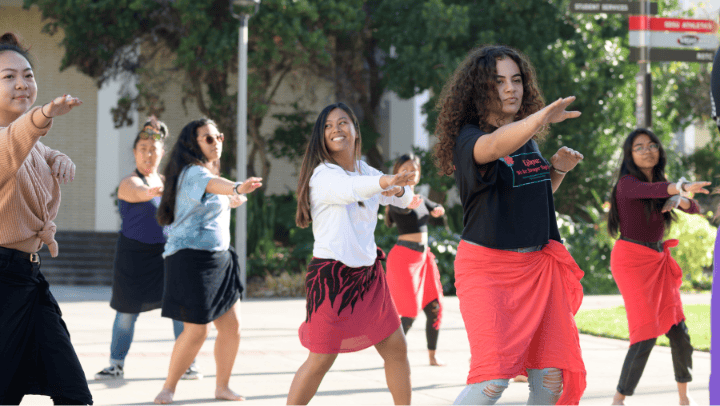Despite Digital Revolution, Distance Still Matters
Researchers find that physical distance still very much matters for human interactions despite the rise of digital technologies.

“The concept of distance is not dissolved, but it has shifted. Now it is more about probability: What is the likelihood, because of distance, that your followers will be your friends in real life?”
Even when people have well-connected social networks beyond their home cities and across state lines, they are still most frequently interacting with people who are geographically nearby.
That is one of the major outcomes of an expansive, 16-month study of more than 51 million geo-tagged tweets generated by more than 1.7 million Twitter users across the United States. The study was funded, in part, by the National Science Foundation.
San Diego State University professor Ming-Hsiang Tsou and alumna Su Yeon Han led the collaborative study, also adopt mapping techniques which allowed for visual analysis of the information.
This type of foundational research is part of a growing body of literature and computational modeling efforts using social media and big data to improve measurements and predictions of human behavior.
“You can Skype and Zoom with anyone. People can buy anything they want from Amazon. It doesn’t matter the location,” said Tsou, founding director of SDSU’s Center for Human Dynamics in the Mobile Age.
With the rise of the Internet and the new era of globalization, some have argued that the world is flat—geography is dead.
“But we disagree with that,” Tsou said, noting that even with shipments, regional supply still influences availability and expedience of a delivery. “The concept of distance is not dissolved, but it has shifted. Now it is more about probability: What is the likelihood, because of distance, that your followers will be your friends in real life?”
If they do not live very close, highly unlikely, Tsou said.
Collaborating with Keith C. Clarke, a geography professor at the University of California, Santa Barbara (UCSB), Han and Tsou published their findings in an article, “Revisiting the Death of Geography in the Era of Big Data: The Friction of Distance in Cyberspace and Real Space.” The article recently appeared in the online issue of the International Journal of Digital Earth.
The team collected tweets via the Twitter Streaming API (application programming interface) between November 2015 and January 2016. Identifiable data, such as a person’s user name, age, gender and occupation, were not included in the dataset.
The team focused on the online and real space interactions of users in four major cities: Chicago, Houston, Los Angeles and New York. Spatial interactions generally include trips, telephone calls and emails, and the team broadened the definition to include any type of connection between places, including people viewing social media messages of those living in other places and “following” others online.

“When we are analyzing social media, or big data, while also handling the geospatial information, we can more precisely analyze data from a regional perspective,” Tsou said.
Studying geo-tagged tweets was essential, as social media data became a proxy for human connection and mobility, said Han, the lead author, now a post-doctoral researcher at the University of California, Riverside (UCR). Han was involved in the study during her time as a post-doctoral researcher at SDSU.
With the massive database of tweets prepared for analysis, the team considered three main issues: how people followed one another, the awareness they had of the cities of their followers and whether they traveled to cities where their followers were located. To compare interactions online versus those in real space, the team studied origins and travel destinations of Twitter users, producing detailed data maps to easily visualize findings.
Of note, the team found that Twitter users averaged 90 percent of their tweets in a single city during the 16-month study period—most often their home city.
In real space, and despite some variation, the team also found that users in all states tended to follow others and have followers well beyond their immediate geographic region—often nationwide. However, according to the study, people are far less likely to have strong awareness of or even give mention to the cities of their faraway followers.
Regional interaction
A sizable number of New York, Chicago and Houston users had online connections that were densely consolidated in regions just beyond their own cities, but users in Los Angeles generally had an expanded network of friends nearby while being well-traveled regionally and nationally. However, they did not enjoy the same level of real life interactions with followers in their very immediate vicinity. The researchers attribute that partially to the entertainment industry, where individuals generally follow well-known celebrities and organizations that never follow them in return.
The team’s research, Han said, could more readily help determine ways to use social media to identify and address social issues and concerns.
“If you are a public health official who wants to spread information about disease prevention, you will be interested in looking at how far and quickly the information spread among people through social media,” Han said. “Also, if you are a political campaigner who wants to spread an election pledge through social media, you will want to see how far and quickly the information spread through people in the social media.”



